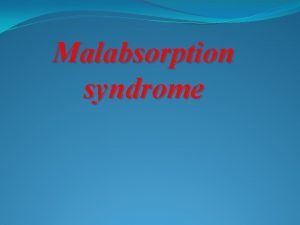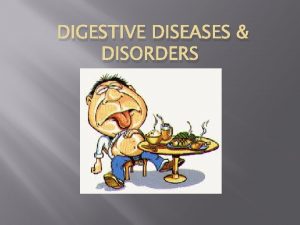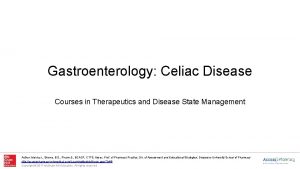Celiac Sprue CELIAC DISEASE IS A SERIOUS GENETIC












- Slides: 12

Celiac Sprue CELIAC DISEASE IS A SERIOUS GENETIC AUTOIMMUNE DISEASE THAT DAMAGES THE VILLI OF THE SMALL INTESTINE FROM CONSUMING GLUTEN, A PROTEIN FOUND IN WHEAT, BARLEY, AND RYE. BY ELIZABETH COLLINS

Is it autosomal dominant or recessive? � Celiac disease is neither indentified as a dominant or recessive gene. Celiac disease is caused by the interaction of multiple genes, both with each other and with environmental factors. Celiac disease does not follow a simple Mendelian inheritance pattern, so are not enough to determine whether celiac disease will occur.

What type of gene? �Celiac Disease is not a sex -linked disease. �Some gene changes (mutations) appear to increase the risk of developing the disease. But having those gene mutations doesn't mean you'll get celiac disease — meaning other factors must be involved. (Not fully counted as a nondisjunction. )

Is it inherited in some other way? �Celiac disease is �Being an autoimmune genetically based, so it is more common in those with a family history of the condition. �This autoimmune condition occurs in up to 5 -10% of family members of persons diagnosed with celiac disease, you can also develop Celiac disease as you get older. �Sometimes celiac disease is triggered — or becomes active for the first time — after surgery, pregnancy, childbirth, viral infection or severe emotional stress.

Healthy gene vs. Afflicted gene

Which chromosomes are affected? �It is well known that celiac disease is strongly associated with specific HLA class II genes known as HLADQ 2 and HLADQ 8 located on chromosome 6 p 21.

Facts about Celiac Disease �About 1 in 141 people in �Most common with the U. S. have celiac disease, although the disease often goes undiagnosed. �Women in the general population are diagnosed with celiac disease two to three times more often than men. Caucasian race. �Affects all age groups.

Symptoms of Celiac Disease � Diarrhea � Weight loss � Constipation � Nervous system injury, including numbness and tingling in the feet and hands, and possible problems with balance � Joint pain � Reduced functioning of the spleen (hyposplenism) � Acid reflux and heartburn � Anemia, usually resulting from iron deficiency � Loss of bone density (osteoporosis) or softening of bone (osteomalacia) � Itchy, blistery skin rash (dermatitis herpetiformis) � Damage to dental enamel � Headaches and fatigue

Testing and Screening � Blood tests. Elevated levels of certain substances in your blood (antibodies) indicate an immune reaction to gluten. These tests detect celiac disease even if you have only mild symptoms or none at all. � Capsule endoscopy uses a tiny wireless camera to take pictures of your entire small intestine. The camera sits inside a vitamin-sized capsule, which you swallow. As the capsule travels through your digestive tract, the camera takes thousands of pictures that are transmitted to a recorder. � Endoscopy. If your blood tests indicate celiac disease, your doctor may order an endoscopy to view your small intestine and to take a small tissue sample (biopsy) to analyze for damage to the villi.

Treatment � A gluten-free diet is essential, and the only treatment for managing celiac disease � Avoid foods with gluten such as: Barley Bulgur Durum Farina Graham flour Malt Rye Semolina Spelt (a form of wheat) Triticale � If your nutrition deficiencies are severe, your doctor may recommend taking vitamin and mineral supplements. � Steroids are also recommend to control inflammation of the small intestine. � If the rash that sometimes accompanies Celiac disease, you may also be recommended skin medication. � If the disease isn't cared for, patients have a greater risk of developing cancers (small bowel, intestinal lymphoma), which could lead to death.

Interesting Facts � 6 -10 years is the average time a person waits to be correctly diagnosed for Celiac disease. �It is estimated that 83% of Americans who have celiac disease are undiagnosed or misdiagnosed with other conditions. �There are NO pharmaceutical cures for celiac disease.

SOURCES �https: //rarediseases. info. nih. gov/gard/11998/celiac- disease/case/43805/case-questions#7269 �http: //www. mayoclinic. org/diseasesconditions/celiac-disease/basics/definition/con 20030410 �http: //www. medscape. com/viewarticle/584122_3 �http: //www. celiaccentral. org/Celiac-Disease/21/
 Malabsorption syndrome
Malabsorption syndrome Pes statement for celiac disease
Pes statement for celiac disease Celiac disease french
Celiac disease french Case study celiac disease
Case study celiac disease Pes statement for celiac disease
Pes statement for celiac disease Celiac disease colville
Celiac disease colville Tufan kutlu
Tufan kutlu Marsh classification of celiac disease
Marsh classification of celiac disease Genetic drift vs flow
Genetic drift vs flow Gene flow vs genetic drift
Gene flow vs genetic drift Genetic programming vs genetic algorithm
Genetic programming vs genetic algorithm Genetic programming vs genetic algorithm
Genetic programming vs genetic algorithm What is gene flow and genetic drift
What is gene flow and genetic drift























